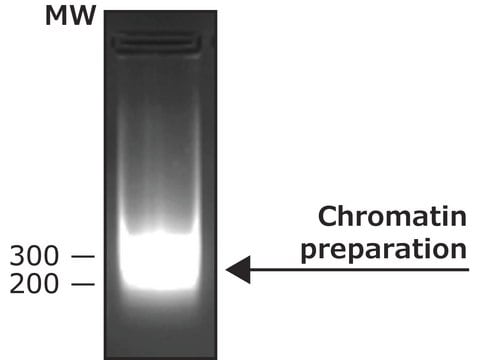SRP2039
FXR (Farnesoid-X-activated receptor) human
recombinant, expressed in E. coli, ≥80% (SDS-PAGE)
Synonym(s):
FXR, Farnesol receptor HRR-1, NR1H4, retinoid receptor
Sign Into View Organizational & Contract Pricing
All Photos(1)
About This Item
UNSPSC Code:
12352200
NACRES:
NA.26
Recommended Products
biological source
human
recombinant
expressed in E. coli
Assay
≥80% (SDS-PAGE)
form
frozen liquid
mol wt
~56.6 kDa
packaging
pkg of 10 μg
color
clear to colorless
NCBI accession no.
UniProt accession no.
shipped in
dry ice
storage temp.
−70°C
Gene Information
human ... HRR-1(9971)
General description
It is part of the superfamily of nuclear receptors. FXR is expressed in the liver and ileum. The gene encoding this protein is localized on human chromosome 12q23.1.
Biochem/physiol Actions
Farnesoid-X-activated receptor (FXR) was originally identified and cloned in rat as an orphan nuclear hormone receptor based on hybridization with a degenerate oligonucleotide designed from the highly conserved nuclear hormone receptor DNA binding domain. FXR functions as a heterodimer with RXR and binds to sequence elements in the promoters of target genes. The FXR/RXR heterodimer binds with highest affinity to inverted repeats separated by 1 bp (IR-1) and with low affinity to direct repeats separated by 4 and 5 bp (DR-4 and DR-5). As is the case for other nuclear hormone receptors, FXR regulates target gene activity in response to ligand. While initial studies suggested that farnesol and retinoid metabolites were likely ligands for FXR, current data support the notion that FXR is a bile acid sensor that plays an integral role in bile acid synthesis and transport. In the small intestine, FXR regulates bile acid uptake through the upregulation of the ileal bile acid binding protein gene via binding to an upstream response element. The FXR/RXR heterodimer can be activated by the bile salt chenodeoxycholic acid (CDCA) and FXR is required for the bile salt-dependent transcriptional control of the human ABCB11 gene (the bile salt export pump). In addition, FXR has been shown to inhibit the cholesterol 7-hydrolase gene (CYP7A1) transcription.
Physical form
Clear and colorless frozen liquid solution
Preparation Note
Use a manual defrost freezer and avoid repeated freeze-thaw cycles. While working, please keep sample on ice.
Storage Class Code
10 - Combustible liquids
WGK
WGK 1
Flash Point(F)
Not applicable
Flash Point(C)
Not applicable
Certificates of Analysis (COA)
Search for Certificates of Analysis (COA) by entering the products Lot/Batch Number. Lot and Batch Numbers can be found on a product’s label following the words ‘Lot’ or ‘Batch’.
Already Own This Product?
Find documentation for the products that you have recently purchased in the Document Library.
Down-regulation of Cholesterol 7a-Hydroxylase (CYP7A1) Gene Expression by Bile Acids in Primary Rat Hepatocytes Is Mediated by the c-Jun N-terminal Kinase Pathway*
Seema Gupta
The Journal of Biological Chemistry, 276 (2001)
Farnesoid X Receptor (FXR) Activation and FXR Genetic Variation in Inflammatory Bowel Disease
Rian M. Nijmeijer
PLoS ONE, 6(8), e23745-e23745 (2011)
Farnesoid X Receptor and Bile Salts Are Involved in
Transcriptional Regulation of the Gene Encoding
the Human Bile Salt Export Pump
Transcriptional Regulation of the Gene Encoding
the Human Bile Salt Export Pump
Jacqueline R.M. Plass
Hepatology (2001)
General molecular biology and architecture of nuclear receptors.
Pawlak M et al
Current Topics in Medicinal Chemistry, 12(6), 486-504 (2012)
W Seol et al.
Molecular endocrinology (Baltimore, Md.), 9(1), 72-85 (1995-01-01)
We have used a yeast genetic system to isolate cDNAs encoding proteins that specifically interact with the ligand-binding domain of human retinoid X receptor-alpha (RXR alpha). A number encoded portions of two known RXR heterodimer partners, the retinoic acid receptor
Our team of scientists has experience in all areas of research including Life Science, Material Science, Chemical Synthesis, Chromatography, Analytical and many others.
Contact Technical Service







